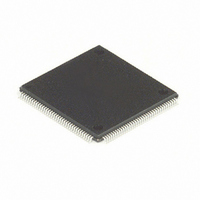MC68HC16Z1CAG25 Freescale Semiconductor, MC68HC16Z1CAG25 Datasheet - Page 173

MC68HC16Z1CAG25
Manufacturer Part Number
MC68HC16Z1CAG25
Description
IC MCU 16BIT 25MHZ 144-LQFP
Manufacturer
Freescale Semiconductor
Series
HC16r
Datasheet
1.MC68HC16Z1VEH16.pdf
(500 pages)
Specifications of MC68HC16Z1CAG25
Core Processor
CPU16
Core Size
16-Bit
Speed
25MHz
Connectivity
EBI/EMI, SCI, SPI
Peripherals
POR, PWM, WDT
Number Of I /o
16
Program Memory Type
ROMless
Ram Size
1K x 8
Voltage - Supply (vcc/vdd)
2.7 V ~ 5.5 V
Data Converters
A/D 8x10b
Oscillator Type
Internal
Operating Temperature
-40°C ~ 85°C
Package / Case
144-LQFP
Cpu Family
HC16
Device Core Size
16b
Frequency (max)
25MHz
Interface Type
SCI/SPI/UART
Program Memory Size
Not Required
Total Internal Ram Size
1KB
# I/os (max)
16
Number Of Timers - General Purpose
11
Operating Supply Voltage (typ)
3.3/5V
Operating Supply Voltage (max)
5.5V
Operating Supply Voltage (min)
2.7V
On-chip Adc
8-chx10-bit
Instruction Set Architecture
CISC
Operating Temp Range
-40C to 85C
Operating Temperature Classification
Industrial
Mounting
Surface Mount
Pin Count
144
Package Type
LQFP
Controller Family/series
68HC16
No. Of I/o's
16
Ram Memory Size
1KB
Cpu Speed
25MHz
No. Of Timers
2
Embedded Interface Type
QSPI, SCI
Rohs Compliant
Yes
Processor Series
HC16Z
Core
CPU16
Data Bus Width
16 bit
Data Ram Size
1 KB
Maximum Clock Frequency
25 MHz
Number Of Programmable I/os
16
Number Of Timers
11
Maximum Operating Temperature
+ 85 C
Mounting Style
SMD/SMT
Minimum Operating Temperature
- 40 C
Lead Free Status / RoHS Status
Lead free / RoHS Compliant
Eeprom Size
-
Program Memory Size
-
Lead Free Status / Rohs Status
Compliant
Available stocks
Company
Part Number
Manufacturer
Quantity
Price
Company:
Part Number:
MC68HC16Z1CAG25
Manufacturer:
FREESCAL
Quantity:
455
Company:
Part Number:
MC68HC16Z1CAG25
Manufacturer:
Freescale Semiconductor
Quantity:
10 000
- Current page: 173 of 500
- Download datasheet (6Mb)
5.9.1.4 PORTC Data Register
5.9.2 Chip-Select Operation
M68HC16 Z SERIES
USER’S MANUAL
SPACE[1:0] determines the address space in which a chip-select is asserted. An ac-
cess must have the space type represented by the SPACE[1:0] encoding in order for
a chip-select signal to be asserted.
IPL[2:0] contains an interrupt priority mask that is used when chip-select logic is set to
trigger on external interrupt acknowledge cycles. When SPACE[1:0] is set to %00
(CPU space), interrupt priority (ADDR[3:1]) is compared to the IPL field. If the values
are the same, and other option register constraints are satisfied, a chip-select signal
is asserted. This field only affects the response of chip-selects and does not affect in-
terrupt recognition by the CPU. Encoding %000 in the IPL field causes a chip-select
signal to be asserted regardless of interrupt acknowledge cycle priority, provided all
other constraints are met.
The AVEC bit is used to make a chip-select respond to an interrupt acknowledge cy-
cle. If the AVEC bit is set, an autovector will be selected for the particular external
interrupt being serviced. If AVEC is zero, the interrupt acknowledge cycle will be ter-
minated with DSACK, and an external vector number must be supplied by an external
device.
The PORTC data register latches data for PORTC pins programmed as discrete out-
puts. When a pin is assigned as a discrete output, the value in this register appears at
the output. PC[6:0] correspond to CS[9:3]. Bit 7 is not used. Writing to this bit has no
effect, and it always reads zero.
When the MCU makes an access, enabled chip-select circuits compare the following
items:
When a match occurs, the chip-select signal is asserted. Assertion occurs at the same
time as AS or DS assertion in asynchronous mode. Assertion is synchronized with
ECLK in synchronous mode. In asynchronous mode, the value of the DSACK field de-
termines whether DSACK is generated internally. DSACK[3:0] also determines the
number of wait states inserted before internal DSACK assertion.
The speed of an external device determines whether internal wait states are needed.
Normally, wait states are inserted into the bus cycle during S3 until a peripheral as-
serts DSACK. If a peripheral does not generate DSACK, internal DSACK generation
must be selected and a predetermined number of wait states can be programmed into
the chip-select option register. Refer to the SIM Reference Manual (SIMRM/AD) for
further information.
• Function codes to SPACE fields, and to the IP mask if the SPACE field encoding
• Appropriate address bus bits to base address fields.
• Read/write status to R/W fields.
• ADDR0 and/or SIZ[1:0] bits to BYTE field (16-bit ports only).
• Priority of the interrupt being acknowledged (ADDR[3:1]) to IPL fields (when the
is not for CPU space.
access is an interrupt acknowledge cycle).
Freescale Semiconductor, Inc.
For More Information On This Product,
SYSTEM INTEGRATION MODULE
Go to: www.freescale.com
5-67
Related parts for MC68HC16Z1CAG25
Image
Part Number
Description
Manufacturer
Datasheet
Request
R
Part Number:
Description:
Manufacturer:
Freescale Semiconductor, Inc
Datasheet:
Part Number:
Description:
Manufacturer:
Freescale Semiconductor, Inc
Datasheet:
Part Number:
Description:
Manufacturer:
Freescale Semiconductor, Inc
Datasheet:
Part Number:
Description:
Manufacturer:
Freescale Semiconductor, Inc
Datasheet:
Part Number:
Description:
Manufacturer:
Freescale Semiconductor, Inc
Datasheet:
Part Number:
Description:
Manufacturer:
Freescale Semiconductor, Inc
Datasheet:
Part Number:
Description:
Manufacturer:
Freescale Semiconductor, Inc
Datasheet:
Part Number:
Description:
Manufacturer:
Freescale Semiconductor, Inc
Datasheet:
Part Number:
Description:
Manufacturer:
Freescale Semiconductor, Inc
Datasheet:
Part Number:
Description:
Manufacturer:
Freescale Semiconductor, Inc
Datasheet:
Part Number:
Description:
Manufacturer:
Freescale Semiconductor, Inc
Datasheet:
Part Number:
Description:
Manufacturer:
Freescale Semiconductor, Inc
Datasheet:
Part Number:
Description:
Manufacturer:
Freescale Semiconductor, Inc
Datasheet:
Part Number:
Description:
Manufacturer:
Freescale Semiconductor, Inc
Datasheet:
Part Number:
Description:
Manufacturer:
Freescale Semiconductor, Inc
Datasheet:











